This was published 1 year ago
‘We made the wrong decisions’: COVID-era mass school closures condemned
Closing Sydney’s schools was one of the biggest - and most controversial - calls during the pandemic. But was it really necessary?
By Jordan Baker and Lucy Carroll
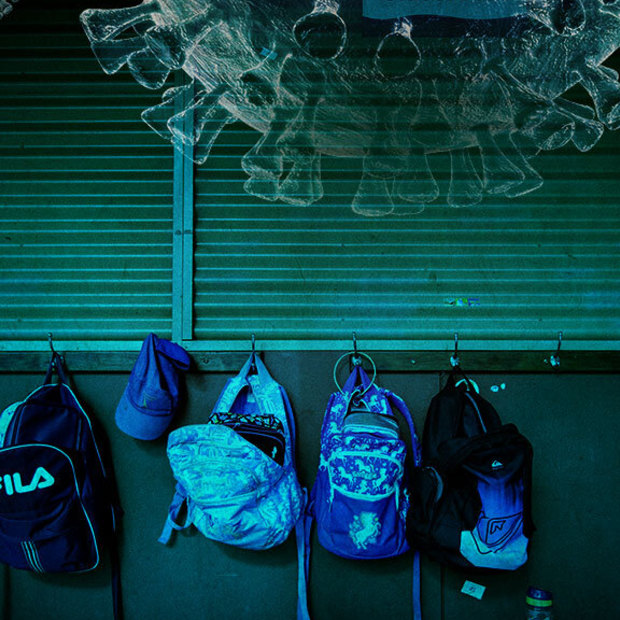
The Sydney Morning Herald hosted a roundtable examining the impacts of COVID-19 policies on schools and students in NSW.Credit: Matthew Absalom-Wong
Mass school closures that stretched for months during the pandemic were unnecessary and led to a cascade of social and educational problems that threaten a generation of Australian children, top education experts say.
Governments have failed to examine the fallout from one of the most far-reaching decisions prompted by COVID-19, which disrupted the schooling of millions of students and resulted in an attendance crisis and persistent behavioural issues.
A panel of pre-eminent Australian education experts has flagged the profound impacts that school closures during COVID-19 have had on students’ education and wellbeing.
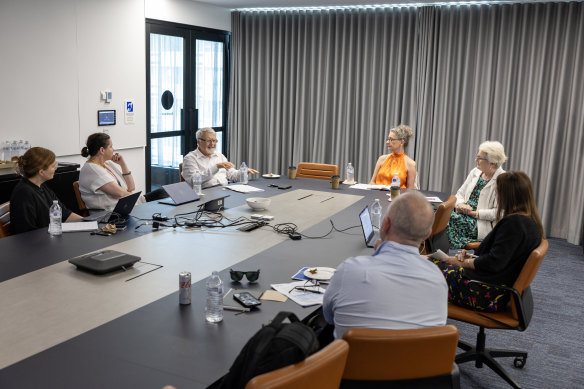
The roundtable of education experts explored the NSW government’s policy decisions, the impact on students and the aftershocks being felt today.Credit: Dylan Coker
They called for a plan for future closures that puts the long and short-term needs of children at the centre of policy decision-making.
The Sydney Morning Herald convened experts on education and child social development to assess the impact of COVID on students after the federal government failed to include the decision to close schools in its independent inquiry into how the nation managed the pandemic.
They included the chair of the NSW education regulator, Peter Shergold, and the National Children’s Commissioner Anne Hollonds.
Schools in NSW switched to remote learning in 2020 and 2021. Strict infection controls continued to interrupt learning and social interaction for months on end.
The COVID fallout: Education
This month marks four years since China’s COVID-19 outbreak was deemed a public health emergency of international concern, heralding the start of a traumatic period many of us would prefer to forget. While a federal government inquiry is examining some national responses to the crisis, key decisions made by states will not be properly scrutinised.
The Herald is concerned our political leaders have not adequately studied the lessons – good and bad – of our most recent experience, and we plan to ask tough questions over the coming months about the pandemic’s impact on education, health, border closures and lockdowns and policing. This is the first of our three-part series looking at the impact of COVID on education. The forum discussions with nine expert panellists were broken up into two sessions: one examining the wellbeing and behaviour of students, the second on academic and learning disruption.
The panellists warned the aftershocks of the decision to close schools are still being felt in classrooms, playgrounds and homes. Some of the worst aspects were the skyrocketing truancy rate, school refusal and significant issues with student discipline and distraction in the classroom, and self-regulation in the playground.
Shergold, a former top public servant who led an independent review into the pandemic in 2022, said the lingering effects of school shutdowns on students, teachers and parents underscored the importance of scrutinising unilateral decisions by state governments to mandate remote learning.
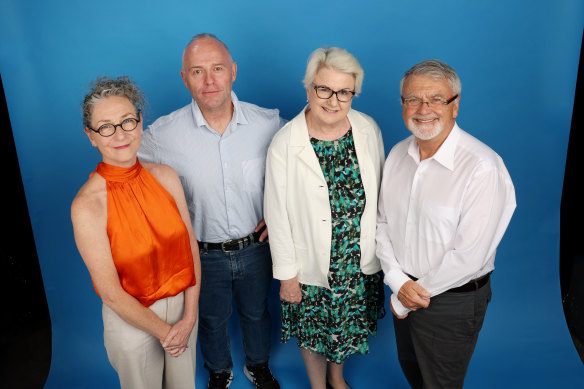
Herald panellists (from left to right): Australian Education Research Organisation chief executive Jenny Donovan, Catholic Schools NSW chief executive officer Dallas McInerney, Fairvale High School principal Kathleen Seto and NSW Education Standards Authority chair Professor Peter Shergold. Credit: Dylan Coker
In September, the federal government announced a long-awaited inquiry into the pandemic response, but school closures are not included in the terms of reference. Former NSW premier Dominic Perrottet has previously joined health experts in urging the inquiry to examine the social damage and repercussions of long periods of remote learning.
“The danger of school closures, which we always knew, was that it was going to accentuate disadvantage,” said Shergold. “After the closures in early 2020, we made the wrong policy decisions about closing school systems.”
In NSW, more than 1.2 million students either learned remotely or had minimal supervision in schools for more than five months. Schools were shut down between March and May in 2020, and then again in 2021 from July to the end of October. Hundreds of schools and childcare centres were closed again in the following months.
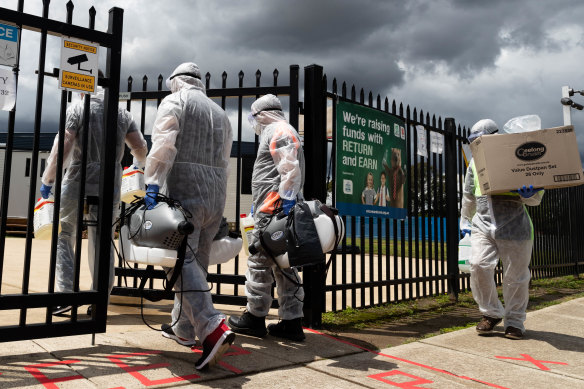
Cleaners arrive at the Malek Fahd Islamic School in Hoxton Park in October 2020.Credit: Janie Barrett
Unlike in Victoria, there was minimal supervision at schools for students, but attendance was discouraged. Shergold said the unity of national cabinet fractured as state governments forged ahead with decisions to shut schools, despite the federal government urging parents to send their children to classes.
State decisions were often politically driven, some panellists said, ignoring the risk of long-lasting impacts on young children and teenagers, especially the most disadvantaged students who were most affected by the closures.
“It was clearly the Commonwealth position to keep school systems open,” Shergold said. “It was states that were unpersuaded, and that’s why this present inquiry seems so bizarre that we’re not going to address their policy responses. It’s a crucial part of the story and ensuring that we’re better prepared for the next pandemic.”
He said early in 2020 there “was a fog of war, and there was ill preparation – in Australia between federal and state governments – for a pandemic”, noting it was understandable schools closed in the first months.
But after evidence emerged that children were less likely to spread the virus, and schools were not transmission hotspots, the system-wide closures were unwarranted, he said.
“We had Treasury pleading with us not to shut school systems. Part of the issue was that parents started to voluntarily withdraw their children from schools, and they were voting with their feet ... I think NSW reacted to that,” he said.
The state government also faced persistent pressure from the NSW Teachers Federation to shut down in-person classes, leaving minimal staffing to support essential frontline services workers. Some of Sydney’s private schools began to defy official advice and close, putting pressure on other systems to follow suit.
The advice provided by chief health officers was that attending school represented a low health risk to students, and studies in 2021 reaffirmed transmission between children in schools was minimal.
Hollonds agreed the first closure early in the pandemic, which lasted seven weeks, was unavoidable, but the longer closure of 2021 was unnecessary.
“Maybe they should have only been short term, where there was a ‘hot-spot’, not the 15 weeks we saw across all of NSW,” she said.
She said the public debate over school closures not only ignored the needs of children, but demonised them as “germy super-spreaders”. “It felt Dickensian, some of that discourse,” she said.
Shergold noted that the shift to online learning was implemented well across systems and schools, and effort was made to address the digital divide. But he emphasised that after the first mass closures a more targeted approach should have been taken to only close individual schools when needed.
Adolescent psychologist Michael Carr-Gregg said school closures, service disruptions and remote learning not only stunted the educational progress of young people, but increased their stress, isolated them and reduced their physical activity.
“All of [this has] contributed to the deterioration of mental health among young people,” he said. “COVID has a long psychological tail.”
Chief executive officer of Catholic Schools NSW Dallas McInerney said for many key decisions, including those made in emergency cabinet meetings, “there was no schools’ voice in the room”.
“So who gave the advice, and who had the ear of the government, was the public health officials. I think whatever legacy or maladies of the school closures, the public health officials own that, and those who accepted their advice,” McInerney said.
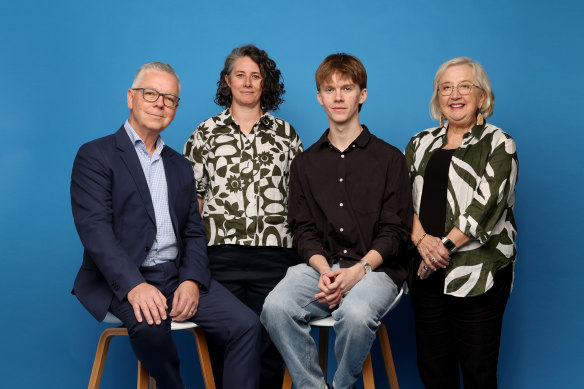
Herald panellists (from left to right): Catholic Schools Parramatta Diocese director of wellbeing Dr Greg Elliott, child psychologist and former school counsellor Kate Plumb, Sydney Secondary College Blackwattle Bay school captain Bede Warnock, and National Children’s Commissioner Anne Hollands.Credit: Dylan Coker
“The notion of school closures is totally dependable and justifiable, as long as it’s informed with policy precision. That a whole school system should be shut down without nuance to that policy was the issue.”
Shergold pointed to an OECD report in September 2020 that noted few groups were less vulnerable to COVID than schoolchildren, “but few groups have been more affected by the policy responses to control the virus”.
“We knew what the impacts would be,” he said. “And there’s no doubt there was an accentuating of disadvantage.”
Australian Education Research Organisation chief executive Jenny Donovan agrees that school closures put a spotlight on the learning gap between disadvantaged students and their advantaged peers.
“In many instances, schools were very concerned about making sure the kids were present and visible online. But attendance just went through the floor. And that has persisted as a problem for us, especially among the older age group of kids,” Donovan said.
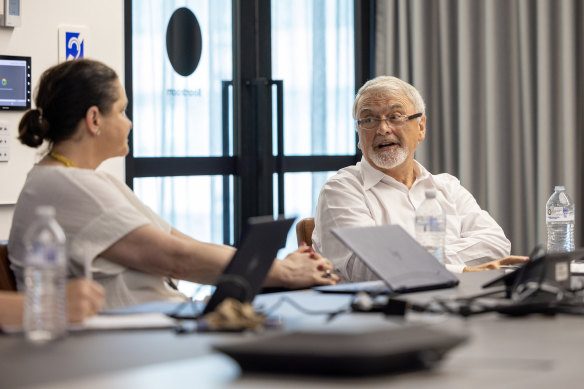
Professor Peter Shergold, chair of the NSW Education Standards Authority, said the Commonwealth position was to keep school systems open.Credit: Dylan Coker
Catholic Schools Parramatta Diocese head of wellbeing Greg Elliott said the debate about closing schools focused too much on the health and safety problems that related to infection, and not enough on the much wider health and safety problems that would result from keeping children away from schools.
“The various industrial bodies were very good at promoting that discourse around health and safety,” he said. “We need to think about health and safety far more broadly than that. We are still seeing the health and safety impacts of COVID in the families and children we’re serving.”
Behaviour, attendance and the school system’s inability to cope with students with special needs were issues before the pandemic.
COVID “revealed the vulnerabilities that were already there, amplified them, and was the catalyst to turn them into something more pathological,” Elliott said.
In the independent report, Fault Lines, a panel led by Shergold concluded schools should have stayed open, and that that politics weakened the national cabinet’s effectiveness over time.
“State leaders insisted on going their own way, emboldened by their constitutional prerogatives. Tough action on COVID-19, including the decision to close schools, was judged politically popular by many state leaders,” it said.
Shergold said he is particularly concerned about the long-term impact of school closures on 15- to 18-year-olds.
“This is the time you’re discovering your identity. I think we might be able to overcome the educational disruption,” he said. “But as for the impacts socially and for their mental health, I am not sure we realised just quite how severe the long-term effects were likely to be. Not just here but all around the world.”
A spokesperson said the NSW Department of Education acknowledged the “incredible work of our schools in supporting ongoing teaching and learning during COVID-19”.
“The department is updating our pandemic response as part of our continuous improvement program in emergency and crisis management. This builds on lessons learned from the pandemic and addresses all aspects of support,” they said.
The spokesperson did not directly answer questions on whether the department had reviewed or planned to review the decision to close schools, or whether it had conducted or will conduct a separate review or inquiry into the impact on wellbeing and education of NSW students.
The Morning Edition newsletter is our guide to the day’s most important and interesting stories, analysis and insights. Sign up here.